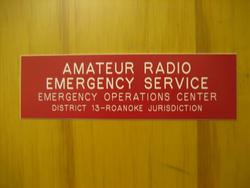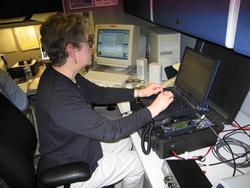 March 18, 2009 Editor: Rick Palm, K1CE | ||
The View from Flagler County Spring training is in full swing, and here's what operators should be pursuing as training at a minimum: ARRL ARECC Level 1 Red Cross Adult CPR/First Aid Basics Red Cross Introduction to Disaster Services FEMA IS-100A (Introduction to Incident Command System) FEMA IS-200A (ICS for Single Resource and Initial Action Incidents) FEMA IS-700 (National Incident Management System) Except for the first two, courses are free of charge, and CPR/First Aid may be free to members of the Red Cross. CPR/First Aid is the only course that requires periodic refreshers; and skills must be demonstrated in person rather than on the Internet. The American Heart Association also has excellent courses available for CPR. (The AHA certifies me as a Registered Nurse in CPR and Advanced Cardiac Life Support -- ACLS -- protocols). These recommendations are pursuant to the ARRL National Emergency Response Planning Committee report to the Board of Directors Annual Meeting, 2007. Get with your Spring training!
Virginia's Operation Deep Freeze Based on an actual event that occurred ten years ago, Operation Deep Freeze simulated 28 miles of highway I-77 in Virginia being closed as a result of a massive winter storm. A simulated rescue effort to remove stranded motorists to a triage area, then to hospitals or shelters as per the need, was also involved. Amateur Radio was used to coordinate these efforts. Amateurs also passed traffic for chainsaw units, feeding units, medical supplies, cots, blankets, snowmobiles, snow shoes, cross country skies, backup relief workers, SAR, inquiries of road conditions, and constant SITREPs. A separate SKYWARN network secured ground truths from the field to make up-to-date reports. This network consisted of three broad coverage repeaters. WXSpots and Winlink were also used in addition to voice to pass weather information to and from the National Weather Service office in Blacksburg, Virginia. Other repeaters and simplex channels were used to handle both priority and simulated emergency traffic. The Old Dominion Emergency Net operated on 3.947 MHz, with the Amateur Radio Communications Auxiliary (ARCA) operating from the Virginia Department of Emergency Management providing net control stations. Communications between the State EOC in Richmond and the impact area 200 miles to the west was handled on the 147.33 MHz repeater.
With the Virginia Defense Force and the Virginia Department of Emergency Management both using the form ICS-213 as their standard message form and the hams in this exercise using the same form, efficiency was achieved for all services. (A number of years ago when MARS and ARES/RACES exchanged messages, the MARS operators used MARSGRAMS and the ARES/RACES used Radiograms, resulting in messages having to be rewritten to be passed). Non-message traffic such as SITREPs and NWS watches and warnings were issued as bulletins with no requirement to be placed in the ICS-213 format. Winlink allowed for more than 60% of the traffic being sent without the need of bogging down a net. Shifting local traffic to simplex from broad coverage repeaters after initial contact on the net frequency also saved net efficiency. Some local nets operated their nets totally on simplex. In summary, 65 Amateur Radio operators operated in the exercise and passed 1025 pieces of traffic. More information and photos: Operation Deep Freeze.
ARRL First VP Kay Craigie, N3KN, and Carter Craigie, N3AO, were among the 65 ops participating in this exercise. N3KN commented: "I operated Carter's portable emcomm station, which can do voice, Winlink, and even CW. We used HF Winlink rather than VHF Winlink from the NWS office so we would not interfere with the voice operators who were on 2m. The messages really flew out of there on Pactor. Then we had the real winter storm on Sunday, which gave this area more snow than people have seen in years. Carter checked into what he thought was going to be the hot-wash net for the drill, but it turned into a real SKYWARN net that he helped to run for several hours. Road conditions did not allow him to go over to the NWS office SKYWARN desk so he did the job from home." - report and photos used with permission of Operation Deep Freeze Leader Glen Sage, W4GHS; and ARRL First Vice President Kay Craigie, N3KN, chairman of the ARRL National Emergency Response Planning Committee (NERPC) (2006) ARRL's K2DCD Addresses EMCOMM University The League's point man for emergency preparedness and response, Dennis Dura, K2DCD, addressed EMCOMM U attendees by video-link at its event on March 14 in Stockton, California. He was a keynote speaker, along with OutpostPM developer Jim Oberhofer, KN6PE. Dura spoke about a number issues for about 30 minutes followed by another 30 minutes of Q&A. Some of the subjects covered were emergency communications training, the need for information during emergency responses, coordination with nationally based organizations and how members can add their ideas on emcomm needs of the ARRL by contributing to the the Strategic Plan. All of this was possible through the efforts of David Coursey, N5FDL who organized this first EMCOMM U effort. "David was very flexible in re-arranging the entire event around my Saturday schedule. He even provided the video camera to make this happen", Dura said. "It was the first time I ever particiapted in this kind of exchange. It's a bit disconcerting at first, but then you don't notice the hardware at all and it becomes just like another QSO, albeit using VoIP and video". Forty-eight area Hams participated and ranged from locations from Lassen Country to the north and Fresno to the south. N5FDL said, "we had 8 speakers, good reviews and it has already improved local agency cooperation based on things people learned". Amateurs Provide Emcomm in Australian Bushfires Amateur Radio operators provided communications links into towns that have had their normal communications destroyed by the bushfires that have decimated Victoria. Members of the Wireless Institute Civil Emergency Network in Victoria (WICEN (Vic)) -- Australia's version of ARES -- were activated on February 8, with members being deployed to areas with loss of power and other facilities. The WICEN HF Net operated on 3.6 MHz daily. A spokesman said "As well as keeping a check on the welfare of operators in the field, the Net was used to pass updated activation information, and also for amateurs in remote areas of the state to check their communications." "It is reassuring to hear stations from all over the state and interstate on the Net, demonstrating that we can, if necessary, establish communications independent of hilltop infrastructure. It has been very handy to have other amateurs monitoring 3.6 MHz when they can to relay when fading occurs. Many thanks to those operators who have relayed traffic." Dennis Dura, K2DCD, ARRL Emergency Preparedness and Response Manager said: "The work the Australian hams have been doing and the issues WICEN have been facing are not unlike what ARES personnel encounter here. The long hours and duration of the disaster response and the dwindling availability of amateur volunteers take a toll. Yet Amateur Radio still is able to complete the mission. The flexibility we bring is key to meeting the emergency communications needs of those the amateur community serves. Our hearts go out to all those that have lost loved ones and whose lives have been forever changed by these fires. Our colleagues in WICEN make the Amateur Radio community proud in the work they are performing in these very difficult conditions." - excerpts from the ARRL Letter Tip: Download Critical Info Regularly If your ARES team keeps configuration or setup information, radio frequency lists, rosters, maps, etc on an Internet server, encourage all members to regularly download the latest versions to their home PCs and laptops. In the case of a power or Internet outage, files will be unavailable from the host. This can be made easier by packaging all of the files into compressed archives (such as ZIP files) that can be downloaded in one operation. Enlist a volunteer to maintain the sets of files and announce when new versions are created. The filename of the archive should include both the date and a version number (eg,"ARES documents - Version 2A - 1 Jan 2009") so that it's easy to tell what version of information a person has.-- Ward Silver, N0AX, AEC Vashon-Maury Island ARES, Western Washington Meetings and Conferences Texas Homeland Security Conference: San Antonio, March 23-26 The Texas State Hurricane Conference on March 23-26 is combined this year with the Texas Homeland Security Conference in San Antonio. This will be an opportunity for State, County, City, and other Emergency Management organizations to meet, attend classes, and discuss possible partnerships. I will be there representing Michael Baker Jr. Inc. with a booth; if any reader is attending, stop by and say hello.-- Eric M. Gildersleeve, KD7CAO, Denton, Texas EMCOMMWEST, Reno, Nevada, May 1-3, 2009 EMCOMMWEST 2009 -- an ARRL specialty convention devoted entirely to emergency communications -- will host this year's Pacific Division Convention (Pacificon) at the Circus Circus Hotel Resort in Reno, Nevada May 1-3. Supervisor of the ARRL's Field and Public Service Team Steve Ewald, WV1X, will host an emergency communications forum and deliver the keynote address. Riley Hollingsworth, K4ZDH, former Special Counsel of the FCC's Enforcement Bureau, will be the speaker at the Saturday evening banquet; Hollingsworth will also present a forum on the legal aspects of emergency communications. Other forums in the works include an introduction to the work of Public Information Officers (PIO) and the PR-101 Course; how to create an effective ARES team; how to work with ARES from an Emergency Manager's view; packet software and operations for emergency communications; practical emergency communication functions for ATV; how to creating a Section-wide intercom using EchoLink and VoIP, and more. SKYWARN and storm spotter training will also be offered. ARRL Pacific Division Director Bob Vallio, W6RGG, and Vice Director Andy Oppel, N6AJO, will lead the ARRL Forum. Registration is now available online at the EMCOMMWEST Web site. TEMA Interoperability Conference, Chatanooga, Tennessee, March 30-31 The Tennessee Emergency Management Agency (TEMA) is hosting its first "Interoperability Conference" on March 30-31, 2009, in Chattanooga. Attending will be the Regional Director of the Department of Homeland Security (DHS) Office of Emergency Communications and other notables, representatives from many of the 96 county EOC/EMAs, including State MARS and Amateur Radio officials. Attendees from the Kentucky State EOC are also expected. Winlink developer Steve Waterman, K4CJX, is a panelist. He reports, "after attending the DHS/ FEMA COML course last month, I can tell you that TEMA is serious about training its volunteer force to be effective participants and partners." Waterman cited an article on the TEMA Web site as an example of its commitment to Amateur Radio. Conference details: "More than Technology -- Tennessee Interoperability Conference and Workshop," March 30 - 31, 2009; Chattanooga Marriott Convention Center, Chattanooga, Tennessee. Opening Luncheon Keynote Speaker Homeland Security Office of Emergency Communications Director Chris Essid. Programs: Interoperability Grant Initiatives and Exercises across Tennessee; National Interoperability Information Exchange (NIIX); Lessons Learned from the 2009 Ice Storm; Frequency Use Sharing Agreements; Panel Discussion Cross Band Devices - Best Practices; HF Radio Amateur Radio (ARES), Military Affiliate Radio System (MARS), WinLink2000 (WL2K) Panel Discussion; Communications Disaster Preparedness and Interoperability. GAREC-2009, Tokyo, Japan, August 24-25 The Fifth Global Amateur Radio Emergency Communications Conference (GAREC) -- hosted by the Japan Amateur Radio League (JARL) -- will be held in conjunction with the JARL Ham Fair at More Conference Leads As written previously in the ARES E-letter, State Conferences, meetings and training opportunities are must attend events for ARES leadership and serious emergency communications radio operators. Attending these events helps to build a good relationship with our served agencies and help you to be a better emcomm provider. The relationships with served agencies are just one major key to sucess, and must be formed before the disaster strikes. Get yourself invited to a conference in your area, present or have a booth showing the capabilities of ARES. Relationships built and knowledge gained at these events will make you a better, more informed ARES member and aid the sucess of the amatuer radio service. Here are just a few conferences I found: South Carolina Hurricane Conference, March 23-26th National Hurricane Conference, April 6-10th Mississippi Hurricane Conference, April 27-29th Florida Hurricane Conference, May 10-15th --Greg Sarratt, W4OZK, Southeastern Division Director Letters: WXSpots Local hams have been using a free software program from N3FJP called WXSpots to post information to those using the software during severe weather conditions such as thunderstorm and tornado watches/warnings. It will also enable Internet chats with hams in the county and surrounding counties as well as non-hams such as those citizens who are SKYWARN trained. We are trying to encourage the use of the software to disseminate information to and from our nets. It obviously has some drawbacks such as electricity and Internet access and cannot always be used by mobile stations. We think of it as one additional tool on our belt. -- Dave Edenfield, W8RIT, Cottrellville Twp, Michigan Letters: More on ARES Notification Modalities In re the item in the last issue on ARES operator alerting methods, I have successfully used a phone notification system for group notices, meeting reminders, et cetera: The service is PhoneVite, and has no monthly fee and the paid service is .05/call. Average time to call 20 people and deliver a message is about 60 seconds. It uses recorded voice so there are no SMS/e-mail delays. I can call home/work/cell and also leave messages. I've been using the service successfully for over one year and my club members love the meeting reminders. I have no interest in the company, just a satisfied user. -- Andy Skattebo, KA0SNL, Quincy, Illinois K1CE For a Final In last month's closing column, Dennis Dura, K2DCD, provided commentary on the increase in ARES activity in support of medical facilities, and correctly identified some of the legal pitfalls. In the same issue was a report on the fascinating work of the venerable Hospital Disaster Support Communications System (HDSCS) of Orange County, California. It struck me that here is an opportunity to hold out HDSCS as a good example of what is not only legal, but what is desirable in terms of ARES protocol in this emerging arena. In the case of HDSCS, Amateur Radio is not the "first line of defense" against hospital phone system failures. Its stated mission is backing up communications that are critical to patient care when normal systems fail. Hospital administrators are certainly on board with that: No competent hospital planner would choose Amateur Radio as the "first line of defense" for his facility's regular back-up communications. If a planner did that, he or she would be choosing an incomplete solution, and which would be impermissible from a Part 97 standpoint. Hospitals have several first options for alternate communications. Such provisions are mandated by rules of the Joint Commission for the Accreditation of Hospital Organizations, although the systems are not specified by the Commission. In addition to in-house VHF/UHF two-way radio systems, hospitals have installed terminals for the HEAR/ReddiNet voice/digital system, a project of the Hospital Association of Southern California, and base stations for a talk group on the county's 800 MHz trunked radio system, a project of Orange County Emergency Medical Services Agency. These systems are correctly the first lines of defense because they are intended to be available 24/7/365 and hospital personnel have been trained to use them. HDSCS is an important additional resource that the hospitals are glad to have, and not always as a last resort: HDSCS operators have to participate in the mix of other back-up systems in lower-level emergencies such as telephone outages and drills (eg, when a backhoe cuts all the telephone trunk lines or a train collision sends victims to hospitals), so they are familiar with hospital procedure and infrastructure for when the "big one" hits. When there is no training, pre-planning and pre-familiarization, when all else fails, Amateur Radio will also fail, and patients are put at risk. HDSCS is a good model to emulate. | ||
 As the area west of the Blue Ridge struggled with heavy snowfall, whiteout conditions and blocked highways, those in the area east of the Blue Ridge faced their own set of winter related problems. The eastern area's precipitation came in the form of heavy icing with simulated reports of between one and two inches of ice. This resulted in the simulation of highways being closed, people stranded, downed utility poles and the loss of power and other utilities. Franklin and Pittlsylvania County operators were actively involved in keeping radio communications going between shelters, the office of Public Safety, and the American Red Cross both locally and throughout the region. They were also in contact with the Virginia State EOC via HF radio and Winlink. This group supported the SKYWARN effort by giving and receiving constant updates between their area and the Blacksburg NWS office.
As the area west of the Blue Ridge struggled with heavy snowfall, whiteout conditions and blocked highways, those in the area east of the Blue Ridge faced their own set of winter related problems. The eastern area's precipitation came in the form of heavy icing with simulated reports of between one and two inches of ice. This resulted in the simulation of highways being closed, people stranded, downed utility poles and the loss of power and other utilities. Franklin and Pittlsylvania County operators were actively involved in keeping radio communications going between shelters, the office of Public Safety, and the American Red Cross both locally and throughout the region. They were also in contact with the Virginia State EOC via HF radio and Winlink. This group supported the SKYWARN effort by giving and receiving constant updates between their area and the Blacksburg NWS office. The
The 





